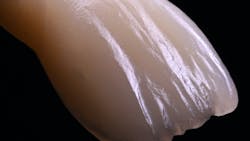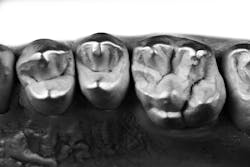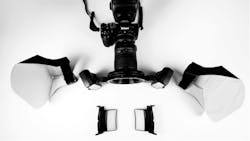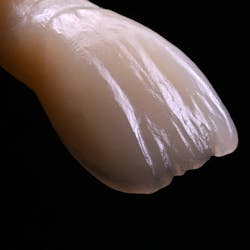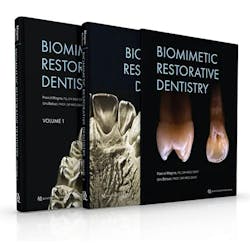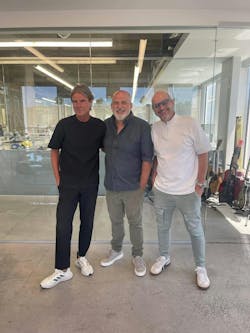Biomimetic restorative dentistry (BRD) from the depths of your heart
Editor’s note: It’s impossible to learn about biomimetic dentistry without acknowledging the contributions of Dr. Pascal Magne. He is a true innovator; he coined these concepts and his extensive research and commitment to education and mentorship is unparalleled. There are many misconceptions about biomimetic dentistry and I couldn’t think of a better person to enlighten us on this topic.
—Dr. Pamela Maragliano-Muniz
What really is biomimetic restorative dentistry?
Dr. Maragliano-Muniz: We see many procedures online that claim to be “biomimetic.” Can you please describe what biomimetic restorative dentistry (BRD) is?
Dr. Magne: This is a quintessential question. It is true indeed that because the word “biomimetic” is not a trademark in dentistry, it can be freely used by anyone. Not all that is presented under this label (especially through social media) is in fact biomimetic in nature. Those who decide to qualify themselves as “biomimetic dentists” show know the true definition of the concept, which implies at least the following seven pillars:
You may also be interested in ... The biomimetically driven restorative dental practice
First pillar: One must be deeply in love with, fascinated by, and passionate about the divine design of the natural dentition.
I always taught my students to pause and enjoy looking at beautiful natural teeth whenever possible.1 Many patients present with intact teeth worthy of observation and documentation. In that regard, having a library of pictures and stone models is a must. As of today, I strongly suggest analogue PVS impressions because digital scans and printers are not able to reproduce the microtexture of natural teeth (figure 1).
Complete records also imply using a top-quality photography equipment (mirrorless interchangeable lens camera (MILC) system, not smartphone or point-and-shoot) with appropriate selections of light-reflecting accessories depending whether you are photographing anterior or posterior teeth (figure 2). I call my camera my third eye because it allows me to see things that are not visible with to the naked eye.
This passion must encompass not only morphology, esthetics, and function, but also the intricacies of mechanics and biology. We must use all possible resources to study the biomechanics of the tooth, which includes understanding stresses and strains within the tooth.2 The esthetic should never be the driving force of the biomimetic approach but merely the cherry on top. This personal commitment to the observation of natural teeth has been an enormous motivator for my research program.
Second pillar: One must strive for prioritizing prevention, and noninvasive and minimally invasive approaches.
The goal should always be the sole elimination of the diseased tissues and the maintenance of all healthy tissues. It goes without saying that the preservation of pulp vitality should be an obsession.
This is in complete contrast with traditional prosthodontic approaches that make a substantial amount of hard tissue sacrifice (enamel, dentin, and even pulp) in the name of retention and resistance form. Crown preparations can be very invasive and increase the risk of endodontic treatment. As I used to tell my students, “You cannot win the Olympic Games of Restorative Dentistry with a nonvital tooth.”
Third pillar: One must become an outstanding bondodontist.
Adhesive dentistry is the true cornerstone of biomimetic restorative dentistry. There is no way of mimicking the natural tooth without optimal adhesion.
While most clinicians recognize the value of enamel bonding, I still see too many colleagues questioning the efficiency of dentin bonding and even refuting the scientifically proven immediate dentin sealing (IDS) technique.
In a sense, their fears are justified by the fact that most adhesives on the market are mediocre, especially simplified products. There are, however, outstanding products that benefit from decades of track record and scientific data to support their performance.
Today a good biomimetic dentist should have knowledge about the gold-standard adhesives, including IDS, and disregard other products until they have a track record. They can easily go to PubMed (pubmed.ncbi.nlm.nih.gov) and type the name of a product. With a few keywords, they should easily see how many articles are listed and how much science is available.
Fourth pillar: One must choose the most appropriate dental restorative materials to replace enamel and dentin.
We currently have a vast choice of possibilities from polymers to ceramics, including CAD/CAM materials and new short fiber-reinforced composite resin (SFRC). For this choice, we need to remember the basic properties of enamel (wear resistance and preservation of shape) and dentin (flexibility and damping of masticatory forces).
Ideally, a specific material is necessary for each tissue, ceramic for enamel and polymers for dentin. However, we also must compromise at times by choosing a single material for low-cost restorations for patients with socio-economic challenges. In that case, highly filled packable composite resins or high-performance CAD/CAM polymers, when possible, are the first choice because they can decently assure the basic properties of both enamel and dentin—wear resistance and resilience. In addition, optical properties of modern composite resins are stunning and require less sophisticated layering than ceramics (figure 3).
Fifth pillar: One must not be bound by or strictly adhere to the principles of retention and resistance form in tooth preparations, as well as radicular posts, because they are the nemesis of biomimetic restorative dentistry.
The motto should be “less is more” because adhesive dentistry is intrinsically conservative. Remember that the better the bond to enamel and dentin, the less critical the need for strong materials (for instance, zirconia-based materials do not belong to the biomimetic realm for the restoration of single teeth), the less critical the design of your restoration (only manufacturing requirements and minimal thicknesses have to be respected) and the less critical the choice of the restorative material itself (e.g. ceramic vs. high-performance polymers).
Each case can be resolved with four basic methods depending on the size of the restoration, the complexity of the case, and affordability by the patient: direct (all steps intraorally in one session), semi-direct (some steps extraorally, in one session), semi-indirect (some steps extraorally in several sessions), and indirect (with the help of an external laboratory in several sessions).
Sixth pillar: One must upgrade one’s armamentarium with essential tools.
These are tools such as high magnification (either loupes at min. x8.0 to x10.0, or microscope for a 25-micron resolution), because “the more we see the less we prep,” but also electric handpieces for optimal torque at low speed for finishing, oscillating handpieces, etc.
Above all one must demonstrate open-mindedness about out-of-the-box techniques such as thermo-modified luting (TML) and deep margin elevation (DME). Some of those techniques aiming at preserving teeth do not need to be scientifically proven when the alternative is tooth extraction.
Seventh pillar: One must prioritize the survival of the tooth, not the restoration.
Restorations should be allowed to fail, and, in most failures, the first choice should be repairing rather than replacing. Traditional prosthodontic approaches were originally focused on the strength of the restoration, prompting the development of extremely high-strength materials that do not require bonding.
Those materials have no place in the biomimetic approach because even the weakest ceramics on the market (feldspathic porcelain) remain stronger than enamel itself and because it is the adhesion to the tooth structure that makes weak materials strong. One should never rely on bench strength of dental material and rather look at the whole assembly once bonded to the tooth.
The best example, of course, is porcelain veneers that are so brittle but almost unbreakable after adhesive delivery. Always remember the story of the helmet and the wool cap: a helmet will shatter into pieces when thrown onto concrete from the 10th floor window. A wool cap would slowly glide down and reach the ground intact. One could easily conclude the superiority of the wool cap.
By the same principle, dental materials’ nominal strength is of no value because materials have to be tested once adhesively delivered to the tooth. I am often asked what I think about zirconia veneers. My answer: they are only stronger than regular veneers until they are delivered to the tooth.
In conclusion, BRD implies a lot of science, but also common sense and experience. Finally, the patient must always be at the center of our decisions because the treatment must also be accessible (see question 4).
BRD vs. Bio-emulation™
Dr. Maragliano-Muniz: How does this differ from Bio-Emulation™?
Dr. Magne: BRD and Bio-Emulation™ share the same DNA, the significant difference being that the word “bio-emulation” is protected by a trademark and cannot be used, or misused, randomly by dental practitioners. The word biomimetic may be used freely in the vernacular, including by colleagues who do not necessarily endorse or practice the principles as described above.
Bio-Emulation™ was created by my dear friend and mentee Dr. Panaghiotis Bazos, whose desire was to make sure that the so-called “Bio-Emulators” remain faithful custodians of the BRD philosophy, by practicing all the biomimetic principles as they continue to develop and evolve over time. For many years, the Bio-Emulation™ Group functioned more like a covenant think tank. Becoming a member was strictly by invitation only and required unanimous approval to preserve the integrity of a hive mind (many minds, one universal mindset).
Today the group is evolving to become a professional society with an education program and accreditation process. The core of the group is very active in research, development, publishing, and education, in the image of Magne EDUCATION (at the Center for Education and Research in Biomimetic Dentistry), which is also part of the accreditation process.
Does biomimetics always improve restorative care?
Dr. Maragliano-Muniz: Can you take a biomimetic approach to all aspects of restorative care or are there specific procedures where a biomimetics may not improve outcomes?
Dr. Magne: All restorative processes can have a biomimetic spin, including implant-supported restorations. I would safely say that implant restorative dentistry is the discipline of restorative dentistry that is currently the furthest from the biomimetic approach. The absence of a PDL and the use of high-elastic modulus fixtures, abutments, and restorations are cumulatively decreasing the compliance of the system.
We published several works aiming at including compliant elements in form of high-performance CAD/CAM polymers (abutment and/or restoration) to compensate for the extreme rigidity of the bone/implant/restoration assembly.3 These approaches, however, have not yet gained popularity.
I always mention that, based on my knowledge of biomechanics and biomaterials, I would prefer to have a posterior implant restored with a composite resin crown in my own mouth. Current approaches that make use of extremely rigid materials are not without complications. It is my sincere hope and wish that more biomimetic implant restorative components would be considered in future research and development.
Science, common sense, and experience
Dr. Maragliano-Muniz: Is there research that supports a biomimetic approach to treatment?
Dr. Magne: I want to insist that the biomimetic approach is not only supported by research, but also by experience and common sense. Research and science are not enough by themselves to be a valid support to BRD, the reason being that science can be flawed.
Humans make mistakes and during the many steps in the making of a scientific work, imperfections can be cumulated. Scientific interpretation adds to the widening of the prediction values. While science is undeniably necessary to the growth of knowledge, it may become much less valuable if not paired with common sense. Common sense is placed by God in your heart. Common sense is the ability to make a good decision. It is based on wisdom (knowing what to do) and discretion (knowing when and where to do it). Common sense triggers further investigation of scientific facts that do not add up. Common sense allows you to look at situations the way God does.
Experience is your story. It is made of the practical knowledge, skill, or elements that you accumulated from direct observation or participation in events or in a particular activity. Experience may be considered as part of science but is not accepted per se as scientific, which is a contradiction because experience is truly priceless.
Finally, science, common sense and experience may lead to a specific therapeutic approach. The patient, however, through informed consent, must be the major decision maker. Timing, affordability, culture, and history might preclude the chosen therapy and call for a different approach. The patient’s constraints and preferences must always be respected.
Dr. Maragliano-Muniz: You have written textbooks about biomimetic restorative dentistry (figure 4), and you have a series of live hands-on courses that you provide. Can you share how we can best learn how to implement a biomimetic approach to restorative care?
Dr. Magne: Implementing BRD implies first that you believe in the validity of the concept, and I guess that the previous answers to your questions should have triggered this process of acceptance, especially the seven pillars we mentioned earlier in this article.
The books and many existing publications are here as a written record for all BRD dentists to consult. I always believed that hands-on experiences are the best way to learn. This belief has been the driving force behind a dream project, which had been overdue for a long time: establishing a Center for Education and Research in Biomimetic Restorative Dentistry (CER BRD).
In 2021, I was approached by Sam Alawie, the CEO of Beverly Hills Dental Laboratory, and business partner of my brother Michel (figures 5 and 6). They offered me the responsibility of creating a comprehensive educational program and facility. After careful planning, I decided to join them in October 2022, and few months later, Magne EDUCATION was established.
The first offer started with a Continuum of five courses of three days each in form of a progressive learning approach. It starts with the basic of dental morphology and visual/perceptual skills in esthetic dentistry (module 1), ultraconservative and direct techniques (modules 2 and 3), and culminates with semi-(in)direct and indirect restorations (modules 4 and 5). You become eligible for certification in BRD after completion of the Continuum program, which includes case presentations and a publishable essay plus lots of one-on-one time during this process.
For those unable to travel or visit us in California, we have also developed an online study club (10 online sessions, 90 minutes each, including interactive discussions). We are constantly growing educational opportunities (photography, orthodontics, endodontics, and periodontics programs, French- and Spanish-speaking intensive programs, etc.) in addition to the existing classes offered by our bio-emulator partners around the globe. Our team includes young graduates such as Dr. Mehrdad Raz (DDS 2019, clinical director) and Taban Milani (DDS 2023, research/education coordinator) and in 2024 we will be launching an independent research program to support our teaching.
Editor's note: This article appeared in the February 2024 print edition of Dental Economics magazine. Dentists in North America are eligible for a complimentary print subscription. Sign up here.
References
- Magne P. A new approach to the learning of dental morphology, function, and esthetics: the “2D-3D-4D” concept. Int J Esthet Dent. 2015;10(1):32-47.
- Magne P. Efficient 3D finite element analysis of dental restorative procedures using micro-CT data. Dent Mater. 2007;23(5):539-48. doi: 10.1016/j.dental.2006.03.013
- Magne P, Silva M, Oderich E, Boff LL, Enciso R. Damping behavior of implant-supported restorations. Clin Oral Implants Res. 2013;24:143-8.
Pascal Magne, DMD, PhD, MSc, director of Magne Education at the Center for Education and Research in Biomimetic Restorative Dentistry, has been widely published, resulting in many awards. He coauthored the book Bonded Porcelain Restorations in the Anterior Dentition—A Biomimetic Approach, with Professor Urs Belser. He served as the Don and Sybil Harrington Professor of Esthetic Dentistry at the University of Southern California from 2004 until 2022, when Magne and Belser published the second edition of their bestselling book Biomimetic Restorative Dentistry.
About the Author

Pascal Magne, DMD, MSc, PhD
Pascal Magne, DMD, PhD, MSc, is currently the Director of Magne Education at the Center for Education and Research in Biomimetic Restorative Dentistry (CER BRD). He has been widely published, resulting in many awards. He coauthored the book Bonded Porcelain Restorations in the Anterior Dentition—A Biomimetic Approach, with Professor Urs Belser (translated into 12 languages). He was recruited as a full-time tenured faculty at the University of Southern California in 2004, and served as the Don and Sybil Harrington Professor of Esthetic Dentistry until 2022, when Magne and Belser published the second edition of their bestselling book Biomimetic Restorative Dentistry, already translated in nine languages.
